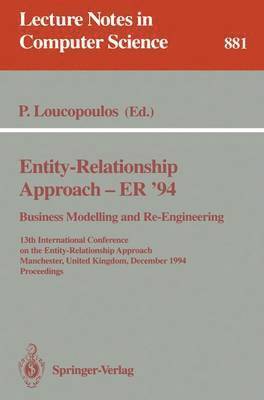
- Format
- Häftad (Paperback / softback)
- Språk
- Engelska
- Antal sidor
- 585
- Utgivningsdatum
- 1994-11-01
- Upplaga
- 1994 ed.
- Förlag
- Springer-Verlag Berlin and Heidelberg GmbH & Co. K
- Medarbetare
- Loucopoulos, P. (ed.)
- Illustrationer
- XV, 585 p.
- Dimensioner
- 234 x 156 x 31 mm
- Vikt
- Antal komponenter
- 1
- Komponenter
- 1 Paperback / softback
- ISBN
- 9783540587866
- 835 g
Entity-Relationship Approach - ER '94. Business Modelling and Re-Engineering
13th International Conference on the Entity-Relationship Approach, Manchester, United Kingdom, December 13 - 16, 1994 Proceedings
- Skickas från oss inom 7-10 vardagar.
- Fri frakt över 249 kr för privatkunder i Sverige.
Passar bra ihop
De som köpt den här boken har ofta också köpt Co-Intelligence av Ethan Mollick (häftad).
Köp båda 2 för 1695 krKundrecensioner
Fler böcker av Pericles Loucopoulos
-
Research Challenges in Information Science
Fabiano Dalpiaz, Jelena Zdravkovic, Pericles Loucopoulos
-
Advanced Information Systems Engineering
Pericles Loucopoulos
-
Design Requirements Engineering: A Ten-Year Perspective
Kalle Lyytinen, Pericles Loucopoulos, John Mylopoulos, William N Robinson
-
Evaluation of Novel Approaches to Software Engineering
Leszek A Maciaszek, Pericles Loucopoulos
Innehållsförteckning
Reflections on the relationship between BPR and software process modelling.- Specifying business processes over objects.- Deriving complex structured object types for business process modelling.- Business process modeling in the workflow management environment Leu.- An assisting method for enterprise-wide conceptual data modeling in the bottom-up approach.- Organisational and information system modelling for information systems requirements determination.- What makes a good data model? Evaluating the quality of entity relationship models.- Database evolution: the DB-MAIN approach.- Database schema evolution through the specification and maintenance of changes on entities and relationships.- Method restructuring and consistency checking for object-oriented schemas.- State-conditioned semantics in databases.- Modelling constraints with exceptions in object-oriented databases.- Declarative specification of constraint maintenance.- On the representation of objects with polymorphic shape and behavior.- A normal form object-oriented entity relationship diagram.- COMan coexistence of object-oriented and relational technology.- Cardinality consistency of derived objects in DOOD systems.- Conceptual modelling and manipulation of temporal databases.- Process repositories: Principles and experiences.- A formal software specification tool using the entity-relationship model.- An overview of the Lawrence Berkeley Laboratory extended entity-relationship database tools.- A generic data model for the support of multiple user interaction facilities.- Using queries to improve database reverse engineering.- Reconstruction of ER schema from database applications: a cognitive approach.- Extracting an entity relationship schema from a relational database through reverse engineering.-Leveled entity relationship model.- Formalised conceptual models as a foundation of information systems development.- Abstraction levels for entity-relationship schemas.- Coordination system modelling.- Virtual structures A technique for supporting scientific database applications.- Resolving fragmentation conflicts in schema integration.- An executable meta model for re-engineering of database schemas.- From E-R to A-R Modelling strategic actor relationships for business process reengineering.- Standard-driven re-engineering of entity-relationship schemas.


